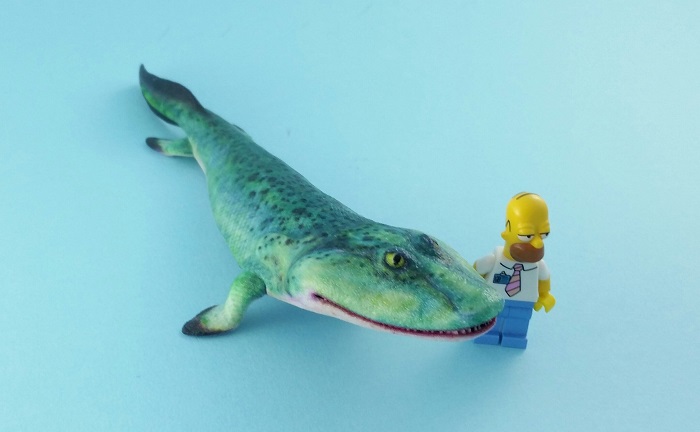It’s easy to think of evolution as a linear process, where one species in the fossil record gives rise to the next in an ever-improving, ever-ascending ladder. But the reality is messier. It’s more like a bush with lots of dead-end branches–any one specimen is unlikely to be our direct ancestor, but many of the transitional forms we find in the fossil record would have been, at least, pretty close relatives of our direct ancestors. Think of it this way: if you went back to the home country of your ancestors and visited a graveyard at random, there’s a chance you’d run across your great-great-great-great-grandparents, but not a great chance. But the chance of finding a distant cousin is actually pretty good.
Let’s go back to the early 2000s. We had fossils like Eusthenopteron, which were pretty thoroughly fishlike in shape and habit. Unlike most fish, it had internal nostrils and a distinct limblike skeleton in its fins. Both of those traits, as well as the histology of its scales and teeth, suggested a relationship with tetrapods (amphibians, reptiles, and mammals). We also had fossils like Acanthostega and Ichthyostega, which had fully formed digits and other tetrapod-like features. We didn’t have much that looked like it could be somewhere between Eusthenopteron and Acanthostega. But paleontologists knew there were rocks of about the right age for such a creature in northern Canada. After a couple of years of searching, they found some fossils in 2004, and published them in 2006, under the name Tiktaalik, an Inuktitut name for burbot (a cod-like fish). It’s since acquired the nickname “fishapod.”

Tiktaalik roseae is a very important fossil, showing a mix of fish and tetrapod characters, but somehow it has never been made into a toy. Luckily, Paleozoo is here to save the day. They’ve made this 3D printed model to fill the gap in the market, just as the fossil itself filled a gap in the known range of morphology.

This model, designed by Australian artist Bruce Currie, is about 25 cm long, making it roughly 1:8 scale for a large (2 meter) specimen. It’s propped up on its famously muscular front fins, which would have allowed it to pop up its head above the water surface to look around or to take a gulp of air.

The model is printed in a gypsum-based material and the top several layers are full color. Unlike the Bothriolepis from the same series, Tiktaalik looks very much like a printed object based on a digital model, which is in fact what it is. Print lines are evident all over the body. The scales and other textural features are printed with darkened edges, which helps give an illusion of depth akin to a dark paint wash on a plastic or resin figure. The physical texturing is relatively restrained, so the overall effect is just a little flat. Sometimes it’s possible to sand a 3D-printed model to reduce the appearance of print lines, and it occurred to me to try that here. However, the tail on my copy suffered a tiny chip in transit, which shows that the lower layers are white, and the relief of the textural details is so small that sanding would probably do more harm than good.

I think the shape of Tiktaalik, especially, the broad, flat head, exacerbate the difficulties inherent in 3D printing. The more boxlike fishes in the line, like the exquisite Remigolepis, give plenty of space for curves to be described in subsequent layers. The fact that the contours of this head and body have to be squeezed into such a small number of layers probably makes it look more artificial, which detracts from what is otherwise a very nicely-proportioned and faithful reproduction of Tiktaalik.

This model is available in a larger size, which probably overcomes some of the printing limitations, but is quite expensive. The 25 cm version is fairly affordable for a print of this quality, and can be had either at Paleozoo or at Shapeways, although I suspect the artist gets a larger cut if you buy direct. I’m also not sure if Shapeways purchases come with this spiffy custom box and information card. Despite a few distracting artifacts of the production technique, it’s a fine model and one of surprisingly few renditions of Tiktaalik available for purchase. I would recommend it to any enthusiast of the Paleozoic or of vertebrate evolution. It makes both a great display piece and educational tool, although I wouldn’t let young children handle it unsupervised.

In particular, I think this is a great model to use in the context of teaching evolution and natural history, showing as it does the features that make Tiktaalik so relevant to the evolution of tetrapods: the forelimbs, the air-breathing adaptations, the jaw morphology. While it’s not very likely that Tiktaalik itself is our direct ancestor, it’s very clearly one of our cousins, so we can learn a lot about our past by studying it.
Disclaimer: links to Ebay and Amazon on the DinoToyBlog are affiliate links, so we make a small commission if you use them. Thanks for supporting us!




Muito show, quero réplica de todas as espécies
I want the tiktaalik toy
Where can I purchase this beast and other amphibians; also prehistoric mammals?
I would also like to purchase this magnificent creature for my personal collection.
The review seems to be truncated for some reason, but the model is available at https://paleozoo.com.au/shop.php
A fine review. Tiktaalik is one of the finest examples of a transitional fossil anyone could ask for—although really, all fossils are transitional when it comes down to it.
or evolutionary dead ends. 🙂
It is fascinating how the process of evolution can be. I cannot believe that specialized and intelligent creatures like human beings evolved from early Paleozoic creatures like Tiktaalik. It is a gorgeous piece, it is nice to see Paleozoo and CollectA tackling obscure species. It is so realistic.